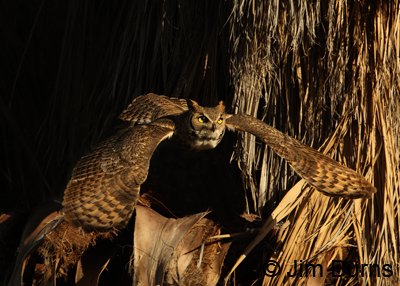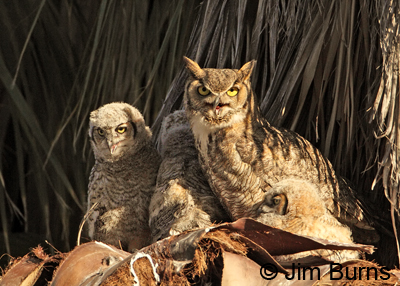
For those of us who love and live Arizona’s outdoor lifestyle, each month on the calendar brings its own special and annual celebrations. For me March is two things--the sweet scent of orange blossoms and the opportunity to observe Great Horned Owls at their nests. This has been a great year for both, especially as I am privileged to be watching four different owl families this spring. I’d like to report I found all four myself, but the truth is that three of them were discovered by friends.
One is in the crotch of an armed Saguaro, one is in a palm skirt, and two are in cliff grottoes high on sheer rock walls. The Saguaro nest is only about fifteen feet off the ground, but the crotch is deep, the cactus has many arms, and the female sits in an opening right up against a residential security wall and shrouded by a mesquite tree, making it difficult to see much going on.
The two grotto nests are quite different from one another. One is in a very large, horizontal, west facing cave with deep recesses where mother and young can escape the direct afternoon sun. The other is in a very small cavern worn into a vertical crack in the rock, the opening, seemingly much better oriented, facing northeast so that it never receives the midday sun. Both are too high for good photography, both inaccessible to anything without wings. And, of course, there’s nothing with wings that would mess with a Great Horned Owl anyway.
The nest in the palm skirt is my stakeout of choice this year. It is not too high, perhaps twenty-five feet, it is wide open to the late afternoon light, and this resident family has two very interesting features—the female has a deformed or injured beak, and the male comes to the nest regularly around 4:15pm, often with prey items for the three babies, dirty white, almost as big as their parents now, and infinitely curious about the new world outside the narrow skirt supporting the massive stick nest.
The most noticeable abnormality of the mother’s bill is that the upper mandible is “sprung” as it were, pushed off somewhat sideways to her right side so that it does not properly engage the lower mandible, the “cutting board.” The lower mandible has a small piece missing along its upper edge about a quarter inch back from the tip on the left side. None of this has hindered her ability to chunk and shred the luckless rodents brought by her mate, and no doubt she will soon be leaving the nest to join him in the hunt, not the least reason being the nest is becoming too crowded for all four of them as the young grow bigger.
On a recent afternoon two Harris’s Hawks, one adult and one juvenile, came in shortly after the male owl had landed near the nest. Both owl parents went on red alert, puffing out their feathers and swiveling about to eyeball the hawks which inexplicably landed in a nearby palm. “Inexplicably” because in this standoff I’d bet the farm on the owls. Great Horneds are known to take Red-tails. That’s “take” as in kill and eat! The Harris’s soon flew off. For the hawks this may have just been spring training, the adult teaching the juvenile to keep its enemies close. For this birder it was just another fascinating day enjoying one of the delights of March here in the desert.